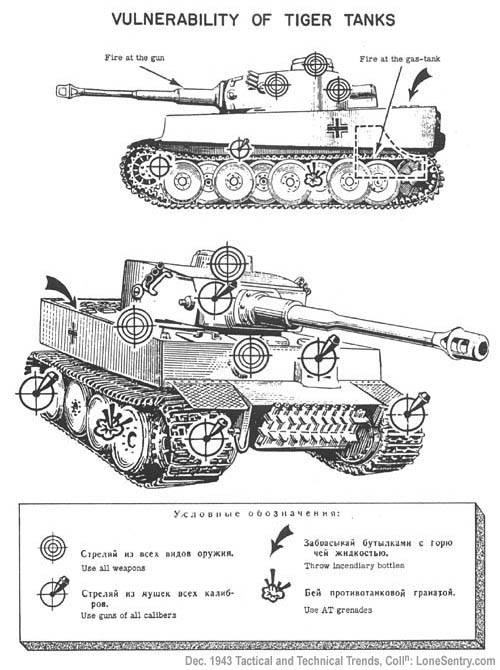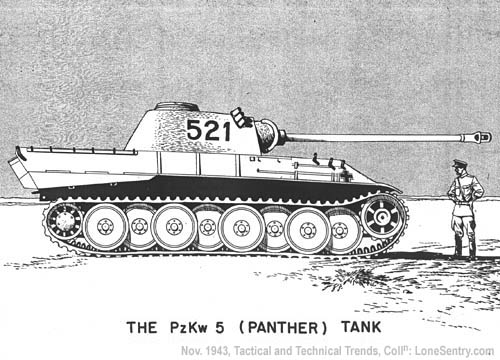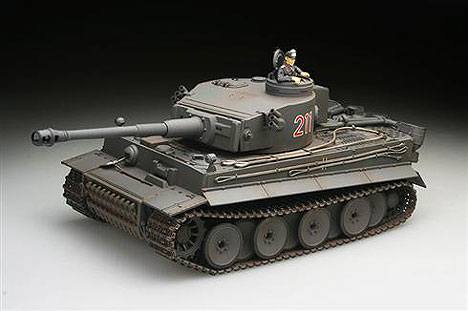
Tiger Tank
The development of the Tiger began as early as 1939. The development programme was accelerated after May 1941 when the Wehrmacht asked for a 45 ton tank which had as its principle weapon an 88mm gun. The 88mm gun had already proved itself in battle as an artillery weapon. The thinking behind carrying such a heavy gun was that it would allow the Tiger to outshoot any gun carried by Russian tanks.

The first Tiger prototype was scheduled to be ready for Hitler’s birthday on April 20th, 1942. This gave the designers a limited time to produce the tank especially as the Wehrmacht was continually changing its design requirements. Companies produced their own versions. The Henschel Company had as their first Tiger prototype a 30 ton vehicle carrying a 75mm gun. However, even before its production, it was out of date as the Russian T34 had better specifications all round. The Porsche Company also competed to produce a tank suitable for the Wehrmacht.

On April 20th, 1942, the new versions from both Henschel and Porsche were displayed in front of Hitler at his base in Rastenburg. The Henschel design was considered to be the more superior and easier to produce in mass production. The full production of the first Tiger tank started in August 1942. The official designation of the new tank was Panzerkampfwagen VI Tiger Ausf. H.
The Tiger I was the first German combat tank to be fitted with overlapping road wheel suspension which gave the tank very good weight distribution. For a tank the size of the Tiger, its ride was stable and was considered to be comfortable for the crew on board. The first Tigers were fitted with two types of tracks – a 20.5 inch track for travel and transportation and a 28.5 version for combat.
However, for all its formidable weaponry, the Tiger had its problems – and one of these centred on the tracks. During the winter, mud and snow would pack into the tracks and freeze up, thus jamming the tracks. When the Russians realised this, they timed their attacks for the early morning before the snow/mud could thaw out. The original Tigers were also underpowered. The first versions were fitted with a Maybach V12 engine with a 21 litres capacity. This was later increased to 24 litres capacity in December 1943. The gearing made the Tiger easy to drive – the 8 forward gears could be used with a pre-selector.
The Tiger I was the first German combat tank to be fitted with overlapping road wheel suspension which gave the tank very good weight distribution. For a tank the size of the Tiger, its ride was stable and was considered to be comfortable for the crew on board. The first Tigers were fitted with two types of tracks – a 20.5 inch track for travel and transportation and a 28.5 version for combat.
However, for all its formidable weaponry, the Tiger had its problems – and one of these centred on the tracks. During the winter, mud and snow would pack into the tracks and freeze up, thus jamming the tracks. When the Russians realised this, they timed their attacks for the early morning before the snow/mud could thaw out. The original Tigers were also underpowered. The first versions were fitted with a Maybach V12 engine with a 21 litres capacity. This was later increased to 24 litres capacity in December 1943. The gearing made the Tiger easy to drive – the 8 forward gears could be used with a pre-selector.










Tiger Tank


No comments:
Post a Comment
Hi, please feel free to share your comment here.
For example: Which pictures is the best?
Thanks,
Admin